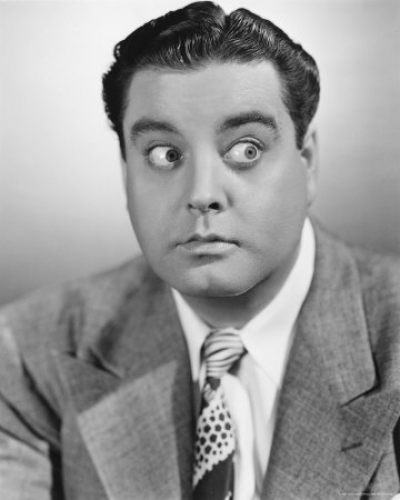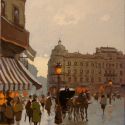
photo:
http://4.bp.blogspot.com/_FXmTwKZmSts/TQIq1xJAUTI/AAAAAAAADHs/5aOhy5zrYZY/s1600/jackie-gleason.jpg
Biography
The early years
Gleason grew up as an only child, abandoned by his father (probably the reason he never mentioned Ralph Kramden having a father on The Honeymooners) and raised by his loving, but work-worn and troubled mother, who died when he was around 16. Gleason first gained recognition in the Broadway play Follow the Girls. He simultaneously appeared in small parts in such films as Springtime in the Rockies, Orchestra Wives (as a swing band bassist---the band itself was played by Glenn Miller and His Orchestra, in Miller's final film project before joining the Army Air Force), and Navy Blues, but he did not make a mark in Hollywood in his early years.
In 1949, he played the role of Chester A. Riley on the short-lived first television version of radio comedy hit The Life of Riley. William Bendix originated the role on radio but was unable to take the television role due to film commitments (including, ironically, a film version of Riley); Gleason's version was favourably reviewed but not high in the ratings. Gleason believed he could do better, and Bendix would revive the show successfully in the early 1950s, but Gleason's nightclub act drew attention from New York City's inner circle---and the small DuMont Television Network.
"And awa-a-ay we go!"
Gleason was hired as the host of DuMont's Cavalcade of Stars and he fashioned a variety hour balanced between glitzy entertainment and his surprising comic versatility. He became one of the few major hits DuMont would enjoy from 1950 to 1952, with some thinking he had a chance to pry the "Mr. Television" title from Milton Berle. With splashy dance numbers framing the show, Gleason began to develop sketch characters that would stay with him for many years, and in 1952 he accepted a big offer to move his extravaganza---renamed The Jackie Gleason Show---to CBS, where he became the nation's number two hit behind another CBS institution, I Love Lucy.
On CBS, he amplified the glitz with splashier, Busby Berkley-inspired opening numbers by the precision-choreographed June Taylor Dancers, before an opening monologue punctuated by a cigarette in one hand and his incessant sipping from a coffee cup many suspected had something a little stronger inside. Then, he would either shuffle comically toward the wing ("A little travelin' music, Sam!" he'd call to his studio bandleader, Sammy Spear) or thrust his hand toward the wing and hail, "And awa-a-aay we go!"---the phrase became one of his trademarks.
Gleason's comic characters included the understated Poor Soul, played silently (and brilliantly) and capable of coming to grief or to surprised pleasure in the most otherwise mundane scenarios; locquacious Joe the Bartender; Rum Dum; and, the character a biographer cited as Gleason's personal favourite---Reginald Van Gleason III, a top-hatted millionaire with an exaggerated brush mustache and perpetual self-satisfied look, who was never shy about savouring the good life and never very far from liquid refreshment. (Ummmmmmmmmmm, boy! that's good booze!). In television's coming-of-age years, the Gleason array was one of the most versatile that any comic delivered.
Hey, there, Ralphie Boy!
But by far his most popular character with his audience was blustery bus driver Ralph Kramden, who lived with his tart but tenderhearted wife, Alice, in a two-room Brooklyn walkup, one apartment beneath his best friend, sense-challenged sewer worker Ed Norton ("The first time I took the test for the sewer I flunked---I couldn't even float!") and his likewise tart wife, Trixie. Partially inspired by the earlier radio hit The Bickersons and largely drawn from Gleason's harsh Brooklyn childhood ("Every neighbourhood in Brooklyn had its Ralph Kramdens," he said many years later), these sketches became known as "The Honeymooners" (possibly a salute to the subtitle of The Bickersons, The Honeymoon Is Over), and customarily centered around Ralph Kramden's incessant get-rich-quick schemes, the tensions between his ambitiousness and Norton's scatterbrained aid and comfort, and the inevitable clash ("whoa-ho-ho...whoa-ho-ho...bang! zooooom!") when sensible Alice tried to pull his crazy, harebrained head back down from the clouds.
"The Honeymooners" first turned up on Cavalcade of Stars (5 October 1951), with Art Carney as Norton and spirited character actress Pert Kelton as Alice. Kelton had voiced five women on a Milton Berle radio show and memorably appeared as a beautiful and bawdy young stage singer in 1933's The Bowery (1933 film) with Wallace Beery and as Constance Bennett's sassy best friend in Bed of Roses (1933 film) that same year. Critics note that the Honeymooners sketches with Kelton were much darker and fiercer than the subsequent softened and more sentimental version with Audrey Meadows. In the two later versions (first with Audrey Meadows as Alice, followed by Sheila MacRae playing the part in the hourlong musical editions in the 1960s), Gleason's character at the very least had a gorgeous young wife, but in the original incarnation with Kelton we meet Ralph Kramden as a young fat man with a middle-aged wife whose looks had faded, and the intense arguments between the two could be harrowingly realistic. When The Jackie Gleason Show---including "The Honeymooners"---moved to CBS, Kelton wasn't part of the move: her name had turned up in Red Channels, the book that listed and described suspected Communists or Communist sympathisers in television and radio (the first Alice Kramden had been blacklisted!), and Gleason reluctantly let her leave the cast, with a typical cover story for the media that she had "heart trouble." He also turned down a younger, prettier actress sent to audition to replace Kelton, but the actress returned dressed as a frump with little makeup---and this time Gleason relented, particularly when he didn't recognise her at first the second time around, and hired Audrey Meadows as the new Alice. She made the role her own, for all intents and purposes. Finishing the cast with an understated but no less effective role was Joyce Randolph as Trixie (Elaine Stritch had played Trixie as a formidably tall and stunning blonde in the first sketch but was replaced by the infinitely more everyday-seeming Randolph the following week).
"The Honeymooners" sketches were so popular that Gleason decided to gamble on making it a separate series entirely in 1955. Perhaps surprisingly, The Honeymooners as its own situation comedy---the so-called Classic 39 episodes, filmed on a new DuMont process, Electronicam, which let live television be saved on high-quality film---didn't catch on as a ratings hit. It would be years later, in what became near-incessant syndication since, that the Classic 39 would become television icons and seen, rightly, as the cleverly elemental and minimalistically brilliant comedies they are. But the concept was acclaimed enough that animators Hanna-Barbera used "The Honeymooners" as the model for their absurdist masterpiece, The Flintstones---whose blustery quarry worker, Fred Flintstone, was a dead ringer for Ralph Kramden; whose dimwitted buddy, Barney Rubble, was a clone of Ed Norton; and, whose tartly loving wives, Wilma and Betty, were the sororital twins of Alice Kramden and Trixie Norton. About the only real difference between The Flintstones and "The Honeymooners," aside from the Stone Age setting, was the Flintstones and the Rubbles having children, Pebbles and Bamm-Bamm. At one point, Gleason was going to sue Hanna-Barbera over the obvious plagiarism, but finally decided against bothering.
Today a life-sized statue of Gleason in full uniform as Ralph Kramden stands outside the Port Authority Bus Terminal in New York City.
Melancholy serenade
Throughout the 1950s and early '60s, Gleason enjoyed a secondary career in recorded music, lending his name to a series of best-selling "mood music" albums for Capitol Records. Like the Beatles and many other songwriters of the following decade, Gleason could not read or write music in a conventional sense; he composed melodies in his head and transposed them with the help of an able staff. (He did likewise with the well-remembered themes of both The Jackie Gleason Show and the Classic 39.) There has been some controversy over the years as to how much credit Gleason should have received for the finished product.
But some of that music endures. "It's Such a Happy Day," which often turned up as a theme behind numerous among Gleason's television sketches, turned up as the music for a jaunty scene involving heart transplant recipient Minnie Driver bicycling around her Chicago neighbourhood in Return to Me.
The American Scene Magazine
Gleason restored his original variety hour---including "The Honeymooners"---in 1956, but within three years Carney had departed and the show had begun to lose its energy. Gleason experimented with a game show, You're in the Picture, which survived its only episode only because of Gleason's hilarious on-the-air apology in the following week's time slot. In 1962, however, he had resurrected his variety show with a little more splashiness (the June Taylor Dancers' routines became more elaborately choreographed and costumed than before) and a new hook---a fictitious magazine through whose format Gleason trotted out his old characters in new scenarios. He also added another catchphrase, "How sweet it is!" (which he first uttered in a 1962 film, Papa's Delicate Condition), rivaling "And awa-a-ay we go!" for its entry into the American vernacular.
Jackie Gleason and His American Scene Magazine was a hit and endured in the format for four seasons---a staple was Joe the Bartender opening his sketch by speaking to the unseen Mr. Dunahy (the viewer) about an article he read in the fictitious magazine, holding a copy across the bar, until the pair were joined by veteran comic and Irish baritone Frank Fontaine as off-centered Crazy Guggenheim, whose cracked banter with Joe inevitably ended with Fontaine displaying his well-trained singing voice. (Fontaine had played the same sort of goofy Brooklynite character, then called "John L. C. Sivoney," on radio's The Jack Benny Program; his wider exposure on Gleason's show resulted in the release of his recordings of 'old standards' on the ABC/Paramount record label.)
Gleason finally abandoned the fictitious magazine and simply re-named his presentation The Jackie Gleason Show. As usual, "The Honeymooners" was a regulation entry, even as the show moved from New York to Miami Beach in 1964, allegedly because Gleason wanted year-round access to the golf course at nearby Inverrary, where he built his final home on one course. But the growing popularity of "The Honeymooners" compelled Gleason to stage periodic, hourlong musical versions of the sketch, sometimes recycling vintages from the 1950s (including a few Classic 39 plots, since the Classic 39 had now begun to attract a new following in syndicated reruns), until by 1968-69 he was doing almost nothing but the hourlong "Honeymooners" musicals. Though received pleasantly, there were those fans---with the Classic 39 to compare---who believed Sheila McRae as the new Alice Kramden and Jane Kean as the new Trixie Norton, as talented as they were, just weren't Audrey Meadows and Joyce Randolph.
Goodnight, Everybody!
At first, "The Honeymooners" musicals helped push The Jackie Gleason Show back into the top five in the ralast in 1970. In the last original Honeymooners episode aired on CBS, "Operation Protest," Ralph Kramden encounters the youth-protest movement of the late 1960s and early 1970s. The times were changing, and Gleason's program was showing its age. With the network also cancelling The Ed Sullivan Show and The Red Skelton Show, both of which had become prohibitively expensive to produce, three of the network's longtime legends went off the air at once.
The flip side of the Great One
Gleason had a dramatic side that the comic pathos of the Poor Soul hinted at often enough. He earned acclaim for live television drama performances in The Laugh Maker on CBS' Studio One (where he played a semi-autobiographical role as fictional TV comedian Jerry Giles), and in William Saroyan's The Time of Your Life, also for CBS, as an episode of the legendary anthology Playhouse 90.
But Gleason's greatest dramatic acclaim came for his portrayal of Minnesota Fats in the 1961 Paul Newman movie The Hustler, in which Gleason---who had hustled pool growing up in Brooklyn---made his own shots on the table. He earned an Academy Award nomination as Best Supporting Actor for the role. Gleason next garnered spectacular reviews as a boxer's beleaguered manager in the movie version of Rod Serling's classic Requiem for a Heavyweight (1962), which also featured Anthony Quinn and a very young Cassius Clay. He topped off a trio of powerhouse dramas as a world-weary Army sergeant, with Steve McQueen supporting him as a Gomer Pyle-like private, in Soldier in the Rain (1962). Tuesday Weld played Gleason's romantic interest.
Gleason wouldn't make that kind of impact on film for over a decade, when he turned up as vulgar sheriff Buford T. Justice in the popular but dubious quality Smokey and the Bandit film series. His career from that point forward would yield either the occasional brilliance (especially, his performance with Sir Laurence Olivier in the cable television special drama, Mr. Halperin and Mr. Johnson) or the hit supporting role that kept him working but wasn't really close to his former brilliance (the Tom Hanks feature, Nothing in Common, featuring Gleason as an infirm, somewhat Archie Bunkeresque character).
The honeymoon wasn't over
After leaving CBS in 1970, Gleason and Carney appeared in several Honeymooners specials on ABC during the 1970s, and a made-for-television movie, Izzy and Moe. In 1985, three decades after the debut of the filmed Honeymooners, Gleason revealed that he had carefully preserved kinescopes of his live 1950s programs with Pert Kelton in a vault for future use. These "Lost Episodes," as they came to be called, first aired on the Showtime cable network in 1986 and later were syndicated to local TV stations. Some of them include what amount to rough drafts of what became better-developed Classic 39 themes, but they proved an invaluable addition to the show's legacy.
And awa-a-ay he went
Nothing in Common proved to be Gleason's final film role. While he made the film, he was already fighting colon and liver cancer. He was hospitalised at one point in 1986-87 but checked himself out and died quietly at his Inverrary, Florida home 24 June 1987. He was 71 years old. In the year of his death, Miami Beach honoured his contributions to the city and its tourism by renaming the Miami Beach Auditorium---where he had performed The Jackie Gleason Show live---the Jackie Gleason Theater of the Performing Arts.
Gleason had an interest in the paranormal, and evidently believed that UFOs represented an unsolved mystery, claiming to have seen them himself. He appeared on John Nebels radio shows on several occasions to discuss UFOs, where, much like Nebel, he presented himself as a curious skeptic. The tabloid National Enquirer reported that Richard Nixon took Gleason to view the remains of aliens killed in the crash of a flying saucer.
Tributes
Sign welcoming drivers to Brooklyn
On June 30, 1988, the Sunset Park Bus Depot in Brooklyn was renamed the Jackie Gleason Bus Depot in honor of the native Brooklynite. (Ralph Kramden, of course, worked for the fictional Gotham Bus Company.) A statue of Gleason as Ralph in his bus driver's uniform was dedicated in August, 2000 in New York City, by the cable TV channel TV Land. The statue is located at 40th Street and 8th Avenue, at the entrance of the Port Authority of New York and New Jersey bus terminal. Another such statue stands at the Academy of Television Arts and Sciences Hall of Fame in North Hollywood, California, showing Gleason in his famous "And awa-a-ay we go!" pose.
Local signs on the Brooklyn Bridge, which indicate to the driver that they are now entering Brooklyn, have the Gleason phrase "How Sweet It Is!" as part of the sign.
A television movie called Gleason was aired by CBS on October 13, 2002, taking a deeper look into Gleason's life; it took liberties with some of the Gleason story but featured his troubled home life (he had children by his first wife; they separated, and Gleason endured a brief second marriage before finding a happy union with his third wife, June Taylor's sister Marilyn), a side of Gleason few really saw. The film also showed backstage scenes from his best-known work. Brad Garrett, from Everybody Loves Raymond, portrayed Gleason (after Mark Addy had to drop out) and Garrett's height (6'9") created some logistical problems on the sets, which had to be specially made so that Garrett did not tower over everyone else.
In 2003, after an absence of more than thirty years, the in-colour, musical versions of "The Honeymooners" from the second Jackie Gleason Show in Miami Beach were returned to television over the Good Life TV cable network. In 2005, a movie version of The Honeymooners appeared in theatres, with a twist--a primarily African-American cast, headed by Cedric the Entertainer. (There had been reports a few years earlier that Roseanne co-star John Goodman would bring The Honeymooners to film and play Ralph). This version, however, bore only a passing resemblance to Gleason's original series and was widely panned by critics, including WNBC-TV's Jeffrey Lyons.
In South Florida there exists a theater named in tribute of her. It is called the Jackie Gleason Theater. Many shows are performed there daily.
TV work
Mr. Halpern and Mr. Johnson (1983)
Izzy and Moe (1985)
Filmography
Navy Blues (1941)
Steel Against the Sky (1941)
All Through the Night (1942)
Lady Gangster (1942)
Tramp, Tramp, Tramp (1942)
Larceny, Inc. (1942)
Escape from Crime (1942)
Orchestra Wives (1942)
Springtime in the Rockies (1942)
The Desert Hawk (1950)
The Hustler (1961)
Gigot (1962) (also writer)
Requiem for a Heavyweight (1962)
Papa's Delicate Condition (1963)
Soldier in the Rain (1963)
Skidoo (1968)
How to Commit Marriage (1969)
Don't Drink the Water (1969)
How Do I Love Thee? (1970)
Mr. Billion (1977)
Smokey and the Bandit (1977)
Smokey and the Bandit II (1980)
The Toy (1982)
The Sting II (1983)
Smokey and the Bandit Part 3 (1983)
Nothing in Common (1986)
Stage appearances
Keep Off the Grass (1940)
Artists and Models (1943)
Follow the Girls (1944)
Along Fifth Avenue (1949)
Take Me Along (1959)
Record albums
Music for Lovers Only (1953)
Music, Martinis and Memories (1954)
Lover's Rhapsody (1955)
Music to Make You Misty (1955)
Tawny (1955)
And Awaaay We Go! (1955)
Romantic Jazz (1955)
Music to Remember Her (1955)
Lonesome Echo (1955)
Music to Change Her Mind (1956)
Night Winds (1956)
Merry Christmas (1956)
Music for the Love Hours (1957)
Velvet Brass (1957)

































